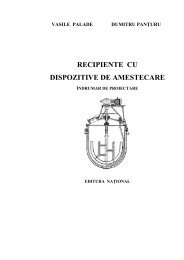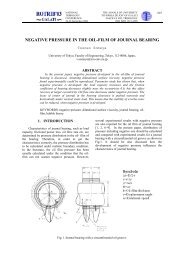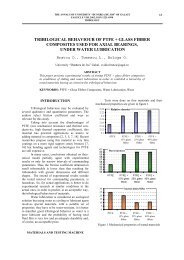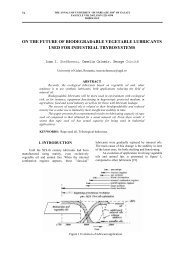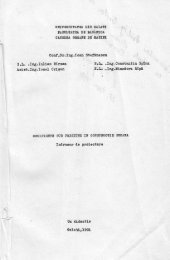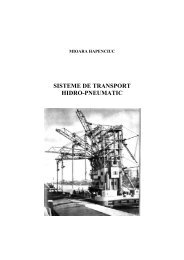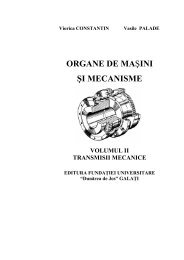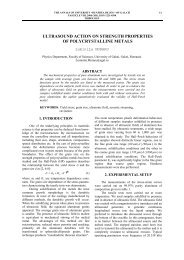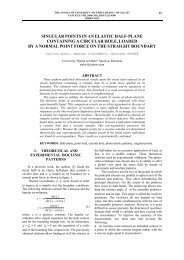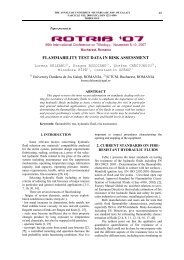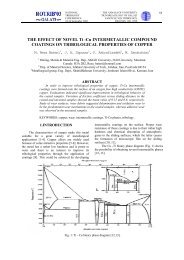INFLUENCE OF A NON-STANDARD GEOMETRY ... - Dunarea de Jos
INFLUENCE OF A NON-STANDARD GEOMETRY ... - Dunarea de Jos
INFLUENCE OF A NON-STANDARD GEOMETRY ... - Dunarea de Jos
Create successful ePaper yourself
Turn your PDF publications into a flip-book with our unique Google optimized e-Paper software.
THE ANNALS <strong>OF</strong> UNIVERSITY “DUNĂREA DE JOS “ <strong>OF</strong> GALAŢI<br />
FASCICLE VIII, 2004, ISSN 1221-4590<br />
TRIBOLOGY<br />
13<br />
sliding velocity, as known, at the first and last points<br />
of contact. It may be seen that in other sections (fig.<br />
4-6) the maximum velocity is gradually increased,<br />
reflecting the increase of the length of the line of<br />
action due to the increase in gear base circle radius.<br />
Section 3, corresponding to the end of the gear<br />
face width, with a base circle radius with 1.6% higher<br />
than the standard value of the consi<strong>de</strong>red geometry,<br />
has an increase of 10% for the maximum sliding<br />
velocity. The sliding velocity is calculated for a speed<br />
of 1000 revs/min.<br />
in section 2 (H 2 = 8 mm)<br />
Fig. 6. The sliding velocity variation<br />
in section 3 (H 3 = 12 mm)<br />
Fig. 3. The sliding velocity variation<br />
in section 0 (H 0 = 0 mm)<br />
Fig. 4. The sliding velocity variation<br />
in section 1 (H 1 = 4 mm)<br />
Fig. 5. The sliding velocity variation<br />
Block [5] was the first who <strong>de</strong>termined the<br />
influence of relative sliding velocity on the flash<br />
temperature between sliding gear tooth surfaces:<br />
0.5<br />
ϕ f = F(<br />
k, ρ,c,w,b,dH ) ⋅v (4)<br />
s<br />
where F expresses the <strong>de</strong>pen<strong>de</strong>nce of flash<br />
temperature (ϕ f ) on the thermal conductivity (k),<br />
<strong>de</strong>nsity (ρ), specific heat (c) of the surfaces, Hertzian<br />
contact length (w), gear facewidth (b) and the<br />
instantaneous energy loss due to friction (dH).<br />
The analysis on curve face width gear geometry<br />
related to the sliding velocity variation, for the above<br />
mentioned dimensional parameters, shows that:<br />
- as the gear tooth height gradually <strong>de</strong>creases; the<br />
maximum reduction is about 6%;<br />
- the maximum sliding velocity gradually increases;<br />
at the end of the gear face width its value is higher<br />
with 10% than the standard value recor<strong>de</strong>d for the<br />
gear centre section;<br />
- the increase in sliding velocity leads to an increase<br />
of 4.8% for the gear’s flash temperature, one of the<br />
components of the maximum gear surface<br />
temperature [8].<br />
4. MESHING CONDITIONS <strong>OF</strong><br />
LOADED PLASTIC GEARS<br />
Polymer gear teeth, with a relatively low<br />
Young’s modulus, will <strong>de</strong>flect elastically un<strong>de</strong>r load,<br />
the <strong>de</strong>flections being larger than those experienced by<br />
metal gears. As a result of the applied load, a<br />
premature engagement takes place, as well as a<br />
<strong>de</strong>layed disengagement. Hence, the contact point for<br />
a plastic gear train is differently positioned compared<br />
to the i<strong>de</strong>al rigid gear pair and is influenced by the<br />
amount of tooth <strong>de</strong>flection.<br />
Gear tooth <strong>de</strong>flections were first calculated by<br />
Timoshenko and Bread [11] and the analysis has been<br />
refined since the original work by many workers.<br />
There are three kinds of <strong>de</strong>flection to be consi<strong>de</strong>red:<br />
<strong>de</strong>flection due to the local surface Hertzian<br />
compression and bending and shear <strong>de</strong>flections.



